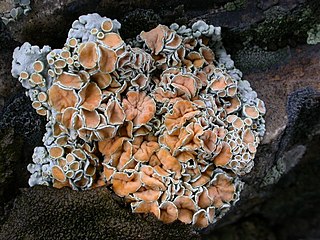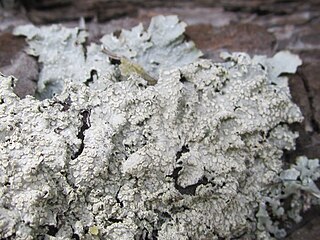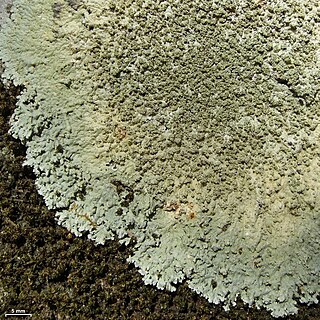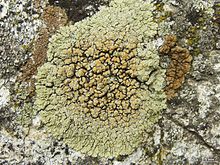Chrysothrix granulosa, the coastal gold dust lichen, is a brilliant yellow, powdery (leprose) lichen that grows in irregular patches mostly on bark in shaded dry areas of coastal western North America and western South America.

Rhizoplaca chrysoleuca is a pale yellowish-green to gray-green umbilicate foiliose lichen in the Lecanoraceae family. It was first described in 1791 by English botanist Sir James Edward Smith as Lichen chrysoleucus; Friedrich Wilhelm Zopf transferred it to the genus Rhizoplaca in 1905.
Hypogymnia congesta is a rare species of foliose lichen in the family Parmeliaceae. Found in China, it was formally described as a new species in 2003. The lichen grows on the bark and wood of conifers and bamboo. Hypogymnia congesta has a brown to brownish-grey foliose thallus measuring up to 8 cm (3.1 in) long or broad, with a cartilage-like texture. The lichen is chemically distinct, containing physodic acid and virensic acid; the latter substance is otherwise unknown from genus Hypogymnia.

Punctelia perreticulata is a widely distributed species of foliose lichen in the family Parmeliaceae. It occurs in Mediterranean Europe and Russia, North America, South America, Australia, and New Zealand, where it grows on rocks, bark, or wood. Its main distinguishing features are its thallus surface, marked with many shallow depressions, grooves, or pits, and sorediate pseudocyphellae. The lower side of the thallus is ivory to tan towards the centre and the major secondary metabolite in the medulla is lecanoric acid. A lookalike species with which it has been historically confused is Punctelia subrudecta; this lichen can be distinguished from Punctelia perreticulata by the texture of the thallus surface, or, more reliably, by the length of its conidia.
Parmotrema lawreyi is a species of corticolous (bark-dwelling), foliose lichen in the family Parmeliaceae. Found on the Galápagos Islands, it was formally described as a new species in 2019 by lichenologists Frank Bungartz and Adriano Spielmann. The type specimen was collected by the first author from the foothills of Media Luna on San Cristóbal Island, where it was found in dry, open woodland growing on the trunk of Bursera graveolens. The species epithet honours the authors' colleague James D. Lawrey, "on the occasion of his 70th birthday".
Parmotrema marcellianum is a species of saxicolous (rock-dwelling), foliose lichen in the family Parmeliaceae. Found on the Galápagos Islands, it was formally described as a new species in 2019 by lichenologists Frank Bungartz and Adriano Spielmann. The type specimen was collected from Cerro Ventanas on Floreana Island at an altitude of 424 m (1,391 ft); there, it was found overgrowing pebbles on sun-, wind-, and rain-exposed ground. The species epithet honours the authors' colleague Marcelo Pinto Marcelli, "in recognition of his work on the lichen family Parmeliaceae".
Leptogium compactum is a species of corticolous (bark-dwelling), foliose lichen in the family Collemataceae. Found in northwestern North America, it was formally described as a new species in 2016 by Daphne Stone, Frances Anderson, and James Hinds. It is distinguished from related Leptogium species by the tightly packed hyphae in the medulla; this characteristic internal anatomy is alluded to in the species epithet compactum.

Leproplaca cirrochroa is a widespread and common species of saxicolous (rock-dwelling), crustose lichen in the family Teloschistaceae. It grows up to 5 cm across, featuring a placodioid thallus with narrow, finger-like lobes that adhere closely to the surface, showing intricate division and ranging in colour from dirty orange to brownish orange, often with paler, pruinose orange ends.
Malmidea cineracea is a little-known species of corticolous (bark-dwelling), crustose lichen in the family Malmideaceae. It is found in Nicaragua.
Placolecis kunmingensis is a species of saxicolous (rock-dwelling), crustose lichen in the family Catillariaceae. It is found in Yunnan, China. The lichen is characterised by a thallus that is areolate to squamulose in its centre, forming irregular patches or clumps 10–50 mm wide, as well as its ellipsoid or spherical ascospores with slightly thickened wall.

Roccella gracilis is a species of fruticose lichen in the family Roccellaceae. Flourishing in coastal environments, Roccella gracilia predominantly grows along the coasts of Baja California and the Galápagos Islands, preferring the trunks, branches, and twigs of trees, but it is also found on rocks and cliffs. Its distribution spans coastal habitats from California south to Peru, including the Galápagos Islands and parts of the Caribbean.

Flavoplaca oasis is a species of saxicolous (rock-dwelling), crustose lichen in the family Teloschistaceae. It is widely distributed across Europe, and has been reported in Western Asia, China, and North Africa.

Glaucomaria is a genus of lichen-forming fungi in the family Lecanoraceae. It has seven species. The genus was circumscribed by Maurice Choisy in 1929. It contains crustose lichens formerly placed in the Lecanora rupicola species complex as defined by several previous authors.
Rhizoplaca ouimetensis is a saxicolous (rock-dwelling), crustose lichen species in the family Lecanoraceae. Uniquely identified by its sorediate form—a feature not observed in other Rhizoplaca species—it was discovered in Ontario, Canada, specifically within the Ouimet Canyon Provincial Park.

Dirinaria aegialita is a species of foliose lichen in the family Caliciaceae. It is found in tropical regions around the world, with scattered occurrences in subtropical North America.
Dirinaria neotropica is a species of lichen belonging to the genus Dirinaria within the family Caliciaceae. It was described by Kalb in 2004.

Dirinaria confluens is a species of foliose lichen belonging to the genus Dirinaria within the family Caliciaceae. It was originally described by D.D.Awasthi in 1975.
Dirinaria frostii is a species of lichen in the family Caliciaceae. It is commonly found in the southeastern United States and Sonora, Mexico. The species was first described by Tuckerman and later classified by Hale & Culberson.
Teloschistes spinosus is a species of corticolous (bark-dwelling), fruticose lichen in the family Teloschistaceae. It is found in Australia and New Zealand.
Awasthia is a monotypic fungal genus in the family Physciaceae. It contains the single species Awasthia melanotricha, a foliose lichen found in the Nepal Himalayas.









